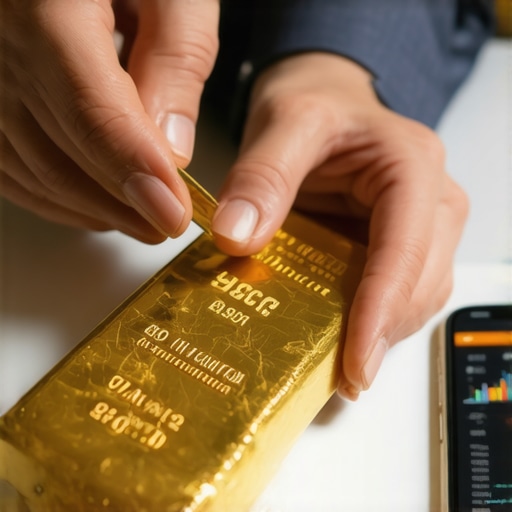Understanding the Basics of Investing in Gold
Investing in gold has long been considered a safe haven for investors looking to diversify their portfolios or hedge against economic uncertainty. As a beginner, navigating the world of gold investments can seem daunting, but with the right checklist, you can make informed decisions that align with your financial goals.
Why Choose Gold as an Investment?
Gold offers several unique benefits that make it an attractive option for both novice and seasoned investors. First and foremost, gold is a tangible asset, which means it holds intrinsic value regardless of market conditions. Additionally, gold often performs well during times of inflation, making it a valuable component of an investment strategy aimed at wealth preservation.
Types of Gold Investments
Before diving into investing in gold, it’s essential to understand the different types available. These include:
- Physical Gold: This encompasses gold bars, coins, and jewelry. Investing in physical gold allows you to directly own the asset, but it also comes with storage and insurance considerations.
- Gold ETFs: Gold Exchange-Traded Funds (ETFs) are a popular way to invest in gold without the need to store physical assets. These funds track the price of gold and can be traded like stocks.
- Gold Mining Stocks: Investing in companies that mine gold can provide exposure to gold prices while offering the potential for dividends. However, these stocks come with their own set of risks related to the mining industry.
Key Considerations Before Investing
As you prepare to invest in gold, consider the following factors:
- Market Research: Stay informed about the gold market by following trends, forecasts, and news that could impact gold prices. For example, understanding how global supply and demand influences prices is crucial.
- Investment Goals: Determine what you aim to achieve with your gold investments. Are you looking for short-term profits or a long-term hedge against inflation?
- Diversification: Gold should be a part of a broader investment strategy. Consider how it fits into your overall portfolio and whether it complements your other investments, such as stocks or real estate.
Finding Trusted Dealers
When investing in physical gold, it’s essential to find reputable dealers. Research potential sellers and ensure they have a solid track record in the industry. You may also want to explore tips for selecting reliable gold dealers to avoid scams and ensure you receive fair prices for your purchases.
Final Thoughts
Investing in gold can be a rewarding endeavor when approached with a strategic mindset. By following this essential checklist, you’ll be well-equipped to make informed decisions and potentially enjoy the benefits that come with gold investments. For further insights, check out our guide on evaluating gold prices and price forecasts to enhance your investment journey.
Understanding Different Gold Investment Strategies
As you delve deeper into investing in gold, it’s crucial to understand the various strategies that can enhance your investment’s performance. Each strategy comes with its own advantages and potential risks, making it essential to choose one that aligns with your financial strategy.
Long-Term vs. Short-Term Investing
Investors often debate whether to adopt a long-term or short-term approach. Long-term investing in gold typically focuses on holding the asset for several years, allowing you to benefit from price appreciation and inflation hedging. Conversely, short-term trading involves buying and selling gold based on market fluctuations, which requires a keen understanding of market trends and timing strategies.
Utilizing Gold Futures and Options
Another advanced strategy involves trading gold futures and options. These derivatives allow you to speculate on the future price of gold without needing to own the physical metal. While they can offer significant rewards, they also come with high risks. Therefore, understanding how gold futures impact market dynamics is vital for informed trading.
Investing in Gold through IRAs
Gold IRAs have become increasingly popular among investors seeking to diversify their retirement portfolios. These self-directed accounts allow you to invest in physical gold, silver, and other precious metals. It’s important to understand the rules and regulations governing gold IRAs, including contribution limits and tax implications. For detailed guidance, refer to our post on gold IRAs.
Assessing Gold Market Trends
To make informed investment decisions, you must stay updated on current gold market trends. Various factors influence gold prices, including geopolitical events, economic data, and changes in supply and demand. By understanding these trends, you can better position your investments for success.
Global Economic Impact on Gold Prices
The performance of gold is often linked to the global economy. During times of economic uncertainty or recession, gold typically sees an uptick in demand as investors flock to safe-haven assets. Monitoring global events that could influence market sentiment is crucial for anticipating price movements.
The Role of Central Banks
Central banks play a significant role in the gold market by holding substantial gold reserves and making decisions that can affect prices. For example, when central banks increase their gold purchases, it can lead to a rise in gold prices due to heightened demand. Understanding the implications of central bank actions on gold prices can enhance your investment strategy.
Practical Tips for New Gold Investors
For those new to gold investing, a few practical tips can help you navigate the landscape effectively:
- Start Small: If you’re new to gold investing, consider starting with a small investment to understand the market dynamics.
- Educate Yourself: Continuously educate yourself about gold investment strategies, market trends, and economic factors. Resources like our guide on investing in gold can be invaluable.
- Stay Disciplined: Stick to your investment strategy and avoid making impulsive decisions based on short-term market fluctuations.
Building a Diversified Portfolio
Finally, consider how gold fits into your broader investment portfolio. A well-diversified portfolio that includes various asset classes can mitigate risks and enhance overall returns. This approach is particularly relevant in volatile markets, where gold can serve as a stabilizing force. For more insights on portfolio diversification, explore our article on diversifying with gold.
Identifying Key Factors Affecting Gold Prices
Understanding the variables that influence gold prices is essential for any investor. Gold prices are not solely determined by market dynamics but are also affected by various external factors, including geopolitical tensions and economic indicators. By analyzing these elements, investors can make more informed decisions.
Geopolitical Tensions and Their Impact
Gold is often viewed as a safe-haven asset during times of political instability. When countries face conflicts or significant political changes, investors tend to flock to gold, driving prices up. Keeping an eye on geopolitical events can provide insights into potential price movements.
Economic Indicators That Matter
Various economic indicators, such as inflation rates and unemployment figures, play a crucial role in shaping gold prices. For instance, rising inflation generally increases gold’s attractiveness as a hedge. Investors should monitor economic reports and forecasts to anticipate how these indicators may influence their gold investments.
Exploring Different Gold Investment Vehicles
Investors have multiple options when it comes to investing in gold, each with its own set of advantages and challenges. Understanding the differences between various gold investment vehicles is essential for maximizing returns.
Physical Gold: Coins and Bullion
Investing in physical gold, such as coins and bullion, allows investors to hold tangible assets. This form of gold investment can be gratifying, but it comes with storage and insurance considerations. For guidance on selecting the best gold coins, refer to our article on essential gold coins.
Gold Exchange-Traded Funds (ETFs)
Gold ETFs offer a convenient way to invest in gold without the need for physical storage. They are traded on stock exchanges and can provide exposure to gold prices while allowing for easy buying and selling. Understanding the nuances of gold ETFs can help investors choose the right fund for their portfolio.
Timing Your Gold Investments
Knowing when to buy and sell gold is crucial for optimizing investment returns. Market timing can significantly impact your profitability, especially in a volatile landscape.
Market Analysis Techniques
Employing market analysis techniques can aid investors in making more strategic decisions. Technical analysis involves reviewing price charts and trends, while fundamental analysis focuses on economic indicators and news events. For a more in-depth look at market dynamics, explore our resource on gold market analysis.
Utilizing Dollar-Cost Averaging
Dollar-cost averaging is a strategy that involves investing a fixed amount of money in gold at regular intervals, regardless of price fluctuations. This approach can mitigate the impact of volatility and reduce the risk of poor timing. It’s a favored method for many investors looking to build their gold holdings steadily.
Final Thoughts on Gold Investment Strategies
In conclusion, investing in gold requires careful consideration of various strategies and market factors. By understanding the nuances of gold investments and adapting to market changes, investors can enhance their potential for success. Whether you choose to invest in physical gold, ETFs, or futures, staying informed and strategic will serve you well in your investment journey.
Evaluating Gold Investment Opportunities
Investing in gold is not merely about purchasing assets; it’s about understanding the market and identifying the right opportunities. With various forms of gold investment available, knowing how to evaluate these options is crucial for achieving optimal returns.
Gold Mining Stocks: Pros and Cons
Investing in gold mining stocks can offer significant returns, especially when gold prices are rising. These stocks can be influenced by both gold prices and the operational efficiency of mining companies. However, it’s essential to assess the financial health and management of mining firms before investing. This approach allows investors to capitalize on the gold market’s fluctuations while mitigating risks associated with mining operations.
Gold Mutual Funds: Diversification Benefits
For those seeking diversification, gold mutual funds can provide exposure to a variety of gold-related assets. These funds typically invest in gold bullion, mining stocks, and other related securities. This diversification can help spread risk and enhance overall portfolio stability. Understanding the different types of mutual funds available for gold investments is essential for making informed decisions.
Understanding Gold Market Trends
Staying informed about market trends is vital for successful gold investments. Analyzing historical data and current trends can guide investors in predicting future price movements.
Analyzing Historical Gold Prices
Historical gold price analysis can reveal patterns that may repeat under similar economic conditions. Investors should examine long-term trends to identify potential entry and exit points. For a comprehensive understanding of gold price movements, check out our article on spotting price fluctuations.
The Role of Central Banks in Gold Prices
Central banks play a significant role in the gold market by buying and selling gold reserves. Their actions can greatly influence gold prices, especially in times of economic uncertainty. By monitoring central bank activities, investors can gain insights into potential price shifts. For more details, read about how central bank purchases influence gold pricing.
Adapting to Market Changes
Being flexible and adaptive in your gold investment strategy is crucial. As market conditions evolve, so should your approach to investing in gold.
Responding to Economic Indicators
Economic indicators such as inflation rates, interest rates, and unemployment levels can significantly impact gold prices. Investors should be prepared to adjust their strategies based on these indicators to optimize returns. Keeping abreast of economic news can offer valuable insights into when to buy or sell gold.
Utilizing Gold as a Hedge Against Inflation
Gold is often seen as a hedge against inflation, making it a preferred choice for many investors during inflationary periods. Understanding how to leverage gold investments to protect against economic downturns can enhance your investment strategy. Read more about the benefits of gold in inflation.
Conclusion: Crafting Your Gold Investment Strategy
In conclusion, a successful gold investment strategy involves careful consideration of various factors, including market analysis, economic indicators, and investment vehicles. By staying informed and adapting to changes in the market, investors can enhance their potential for success in the gold market.
Frequently Asked Questions About Gold Investment
What are the benefits of investing in gold?
Investing in gold offers several benefits, including portfolio diversification, a hedge against inflation, and protection during economic downturns. Gold’s value often remains stable or increases in times of economic uncertainty, making it a safe haven asset.
How do I start investing in gold?
To start investing in gold, you can choose from various options such as purchasing physical gold (jewelry, coins, bars), investing in gold mining stocks, gold mutual funds, or ETFs. It’s essential to research and choose the investment method that aligns with your financial goals and risk tolerance.
Is gold a good investment in 2025?
While predictions can be challenging, many analysts believe that gold will continue to play an essential role in portfolios due to ongoing economic uncertainties and inflation pressures. Investors should keep an eye on market trends and economic indicators to make informed decisions.
What are the risks associated with gold investments?
Some risks include market volatility, the potential for price fluctuations, and the lack of income generation from physical gold compared to stocks or bonds. Investors must be aware of these risks and consider their investment horizon and strategies accordingly.
How can I determine the right time to invest in gold?
Identifying the right time to invest in gold involves analyzing market trends, economic indicators, and gold price movements. Keeping informed about global economic conditions and central bank policies can also provide valuable insights into potential investment timing.
Can I invest in gold through my retirement account?
Yes, you can invest in gold through a self-directed IRA, which allows you to include physical gold and other precious metals in your retirement portfolio. Ensure that your custodian is approved to handle such investments.
What is the difference between gold bullion and gold coins?
Gold bullion refers to gold bars or ingots that are traded based on weight and purity, while gold coins are minted items that often have a face value and can be considered collectibles. Both can be good investment options depending on your strategy.
How does gold perform during economic downturns?
Gold typically performs well during economic downturns as it is viewed as a safe haven. Investors tend to flock to gold to preserve capital and hedge against the risks associated with declining stock markets and currencies.
Authority Resources for Gold Investment Insights
For further reading and research, consider these trusted resources:
- Kitco Metals – A leading gold market information source that provides real-time pricing and analysis.
- World Gold Council – An authoritative body that conducts research and provides insights into gold investment and its global market.
- Investing.com – Offers a comprehensive view of the gold market along with economic indicators that affect gold prices.
- Bloomberg Markets – Provides current news and analysis on commodities, including gold.
- Forbes Precious Metals – Features articles on investing in precious metals, including expert opinions and market analysis.
Conclusion: Your Path to Successful Gold Investment
In summary, investing in gold necessitates a thorough understanding of market dynamics, economic indicators, and various investment vehicles. By leveraging the insights provided in this guide and utilizing authoritative resources, you can craft a robust gold investment strategy that aligns with your financial goals. As you navigate the complexities of the gold market, remember that informed decisions and adaptability are key to maximizing your investment potential in gold.











As someone new to the world of investing, I found the breakdown between physical gold, ETFs, and mining stocks particularly helpful. I’ve been mainly considering physical gold because I like the idea of owning tangible assets, but the issues with storage and insurance make me a bit hesitant. On the other hand, Gold ETFs seem like a convenient alternative without the hassle of storage. However, I wonder about their liquidity during market downturns compared to physical assets. The emphasis on understanding market research and diversifying gold investments within a broader portfolio resonates with me—especially since combining gold with stocks and real estate seems to balance risk better. I’m curious to hear from others: how do you balance the tangible security of physical gold with the ease and flexibility of ETFs or mining stocks? Have you found a strategy that works best for both preserving value and generating potential income? Also, when starting small, how did you determine which type of gold investment to dip your toes into first?